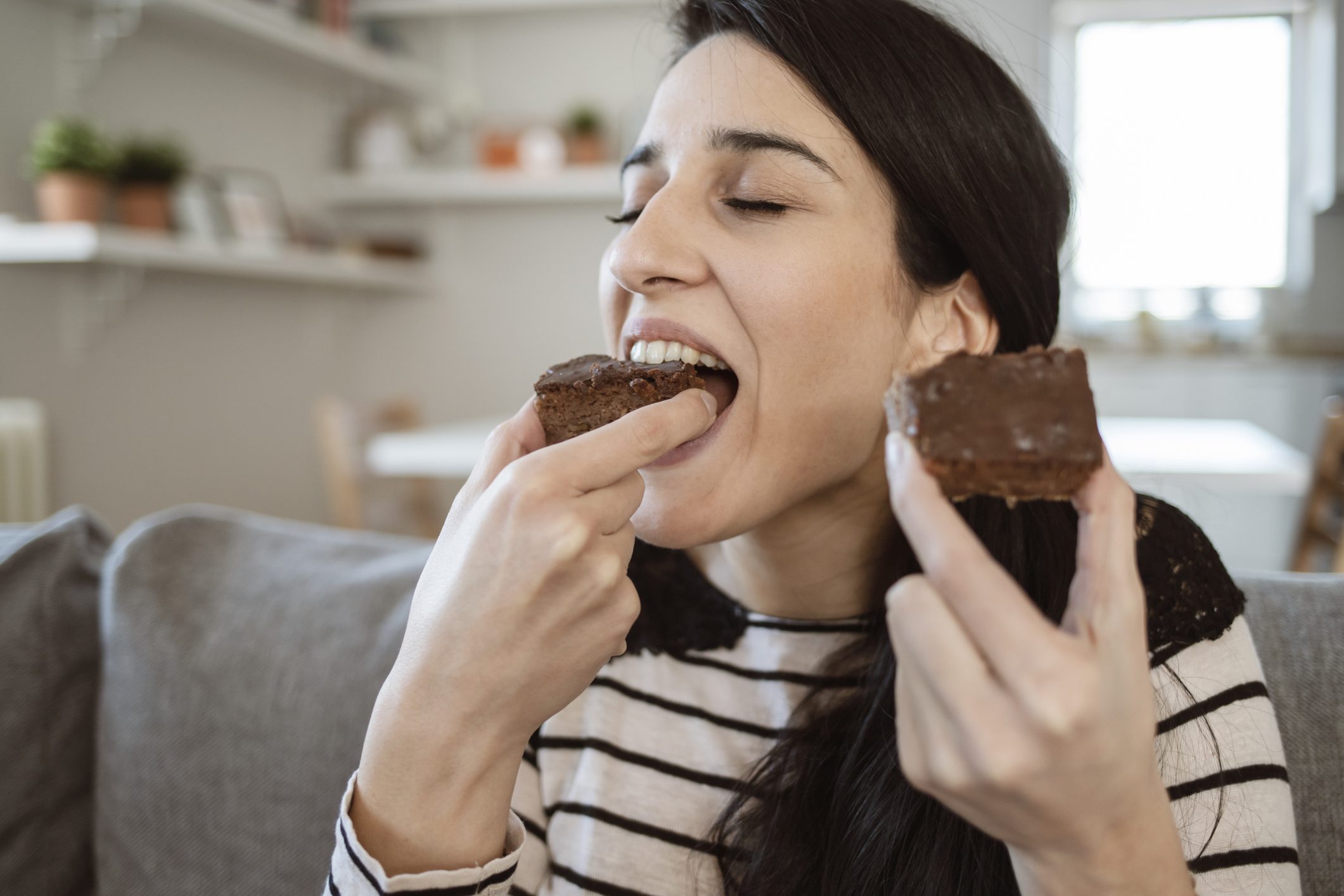No wonder you’re craving sugar—it’s impossible to escape! Not only is it in the sugary drinks, processed foods, and snacks you see advertised and sold everywhere, it’s also in the food you’ve been told is “healthy,” like whole-wheat bread, yogurt, and salad dressing.
I’m not going to sugarcoat how bad that is (because we’ve got to start ditching the sugar coatings somewhere!). The higher your intake of sugar, the higher your risk for developing chronic conditions like heart disease, inflammation, high blood pressure, and type 2 diabetes.
Plus, consuming tons of sugar makes it more difficult for you to maintain the weight you want. Over time, a diet high in sugar can inhibit the hormone leptin, which plays a role in telling your brain when you’re full. When it’s not functioning well, it won’t let your brain know that you’re full, causing you to overeat. Talk about a catch-22—the more sugar you eat, the more you’ll crave.
But if you’re here, you probably know that. You’re a human living in a world bombarded by sugar, and you know the havoc it’s wreaking on your body. You want to stop—but how do you curb those cravings? Get started with these steps.
1. Get to the Root of Your Cravings
You can’t truly say goodbye to sugar cravings if you’re not cutting them out at the root. Everyone is different, and you might experience cravings for any combination of these reasons:
Genetics
We’re all a little hardwired to crave more sugar once it’s in our system, but your genes might be making you even more predisposed to craving sweet treats. Researchers found that people with a particular variant of one of the hormones produced by your liver cells, FGF21, were more likely to name sweets as their treat of choice.1
If your genetics are working against you to give you more of a sweet tooth, you might have to work harder at curbing your cravings—but it’s still possible!
Brain Training
The more you consume artificial sweeteners or unnatural sources of sugar like high-fructose corn syrup, the more they train your brain to desensitize your tastebuds because they are significantly sweeter than natural sugars. Aspartame, the artificial sweetener that flavors popular products like Diet Coke and NutraSweet, is about 180 times sweeter than regular sugar.2
Over time, the natural flavors of whole foods (including savory and spicy flavors) won’t be good enough for your brain anymore, and it will have you craving the intense sweeteners of artificial sugars.
Unhealthy Microbiome
When your gut doesn’t have enough of the good kind of bacteria it needs to thrive, it can signal your brain to overeat “palatable” foods like sweet treats.3
Mammals are hardwired to eat for fuel, but also for pleasure. So in a misguided way of desperately trying to correct itself, an unhealthy gut might signal that it wants to eat foods you’ve found immense pleasure in before, in the hopes that it will find some good bacteria there. By healing your gut, you can make sure it’s not telling you to overeat.
Food Intolerance
Here’s something pretty unfair about food intolerances: sometimes, your brain craves the very thing that’s making you feel not-so-great. It’s like a high—these inflammatory (but delicious) foods raise your endorphins at the same time they raise your blood sugar, so you’re triggered to eat more. Being mindful of this destructive cycle can help you nip it in the bud!
The Virgin Diet teaches you everything you need to calm inflammation from hidden food sensitivities, reclaim your health, and feel more energized and better than ever!* Enroll and join hundreds of others on your path to better health.
Insulin Resistance
Insulin’s job is to move glucose from the blood and into the cells after you eat. However, when you consume too much sugar, especially in the form of added sugars, your body may produce more insulin than necessary. Over time, this can make your cells less sensitive to insulin, leading to insulin resistance and elevated blood-sugar levels.
This can also lead to cravings in the short term and set you up for type 2 diabetes long-term. To counter it, wear a continuous glucose monitor to track your blood-sugar levels throughout the day, so you can see if they’re unusually high or what triggers them. Talk to your healthcare provider about looking at your triglycerides and your cholesterol levels (both LDL and HDL) to figure out if insulin resistance might be causing you to crave the sugar your body isn’t properly processing.
Chronic Stress and Anxiety
Stressed out brains lack serotonin, the hormone that helps relax you. Guess what can give your brain a little serotonin boost? Yup—sugar.
Though it may seem to help in the moment, feeding those cravings will only intensify them over time, worsen your health, and exacerbate the stress that made you crave sugar in the first place. A better solution is to try some of my favorite chronic stress relievers, like mediation, exercise, and Nick Ortner’s Tapping Solution.
Once you get to the bottom of your cravings, you can start to treat them at the source. No matter the reason, it’s possible to retrain your brain to be satisfied with the natural sugars you get from great whole foods and kiss those cravings goodbye.
But if they’re still creeping up, I’ve still got a few more suggestions:
2. Eat by the Plate Three Times Every Day
Retraining tastebuds doesn’t happen overnight—it happens every single day, when you fuel your body with clean protein, healthy fats, fiber, and slow-low carbs for each of your three meals. I call it eating by the plate.
A typical meal looks like:
- 1 lean, clean serving of protein, like fish, chicken, or grass-fed beef
- 2-4 servings of healthy fats, like olive oil, avocado, nut butters, or fatty fish like salmon
- 2 or more servings of non-starchy vegetables, like broccoli, green beans, zucchini, mushrooms, or peppers
- 0-2 servings of high-fiber, slow-low carbs, like sweet potatoes, cooked beans, or fruit
When you make meals like these your norm, they will satisfy your mind and body enough to prevent it from thinking it needs more sweets.
I love kicking my morning off with a loaded smoothie full of protein, fat, and fiber to fill me up and keep cravings at bay throughout the day. Not sure how to prepare one of your own? Download my FREE Loaded Smoothie Cookbook and for over 60 satiating recipes with rave-worthy flavor.
3. Understand the Impact of Artificial Sweeteners
Artificial sweeteners are a food-science experiment gone horribly wrong. Each time you take a sip of diet soda or coffee with Splenda, you’re training your brain to crave not just more sugar, but an artificially manufactured sweetness that isn’t attainable from naturally sweet foods. It jumpstarts an endless cycle looking for that sensation in all kinds of foods (that can contribute to chronic health issues) without being satisfied from any of them.
If you can’t kick the artificial-sweetener habit quite yet, reach for smarter alternatives. My favorites are allulose, monk fruit, and stevia. Remember to read the label of these products (there shouldn’t be extra ingredients like corn or bulking agents) and use sparingly in order to help your brain reset.
4. Digest Your Protein Well
Even if you’re consuming the right amount of protein for your body, it’s possible you aren’t digesting it properly. Without enough protein digested, your brain doesn’t release enough leptin, the hormone that lets your body know you’re full. So you’ll reach for more food, even if you’re not hungry or it’s not what your body needs to function.
Some of the reasons you might not be breaking down protein include chronic conditions like IBS or lactose intolerance, intestinal damage from surgery, or taking certain medications like antacid.
A digestive enzyme can help with that. A comprehensive formula like my Protein First Enzymes can be taken before every meal to help break down protein, but also fats, carbs, gluten, and soy. They also help to minimize bloating and ensure your body is digesting the fuel it needs to thrive.*
5. Pay Attention to Labels
Sugar is sneaky! It’s creeping into your diet in more ways than you realize. And remember—the more sugar you eat, the more you crave, so you could be unknowingly fueling those cravings despite your best intentions.
You might already be avoiding foods you know are packed with added sugars, like soda and packaged cookies. But make sure you’re reading the labels of everything you buy. Supposedly “healthy” culprits that might secretly be full of sugar include wheat bread, whole-grain cereal, sauces and salad dressings, tortillas, baked beans, and dried fruit.
Be especially on the lookout for low-fat items. If they’ve taken out the tasty fat, they’ve likely replaced it with some sugar to make it more palatable. Instant oatmeal, dairy alternatives, packaged green juices, yogurt, and reduced fat or “light” versions of cereals, nut butters, frozen meals, and cheeses are popular sneaky sugar sources.
6. Try My Lemon-Aid
Did you know sour or fermented flavors can help curb sugar cravings? My favorite way to get some sour flavor is my homemade Lemon Aid recipe. It’s a super multitasker—along with fighting off cravings, it can also help regulate your blood sugar, support your gut and digestion, give you a quick hit of antioxidants, and be a refreshing treat on a hot day.*
Kicking cravings is never easy, especially for something as ubiquitous as sugar. But by getting to the root of your cravings and treating yourself to satisfying, low-sugar impact foods, you’ll undergo the reset you need to help your brain and body function at their best.
The most effective way to reel in your sweet tooth is to move through my Sugar Impact Diet. Your taste buds can change in as little as two weeks (and so can your waistline)! Lowering your sugar impact is also the single biggest needle mover when it comes to weight loss, great energy, and overall health.* Get the book and try it for yourself here.
References:
- Jensen-Cody, S. O., Flippo, K. H., Claflin, K. E., Yavuz, Y., Sapouckey, S., Walters, G. C., Usachev, Y. M., Atasoy, D., Gillum, M. P., & Potthoff, M. J. (2020). FGF21 Signals to Glutamatergic Neurons in the Ventromedial Hypothalamus to Suppress Carbohydrate Intake. Cell Metabolism, 32(2).
- Magnuson, B. A., Carakostas, M. C., Moore, N. H., Poulos, S. P., & Renwick, A. G. (2016). Biological fate of low-calorie sweeteners. Nutrition Reviews, 74(11).
- Ousey, J., Boktor, J. C., & Mazmanian, S. K. (2023). Gut microbiota suppress feeding induced by palatable foods. Current Biology, 33(1).
*These statements have not been evaluated by the Food & Drug Administration. Products mentioned are not intended to diagnose, treat, cure, or prevent any disease. The views in this blog by JJ Virgin should never be used as a substitute for professional medical advice. Please work with a healthcare practitioner concerning any medical problem or concern.





